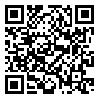Volume 13, Issue 51 (2020)
LCQ 2020, 13(51): 1-30 |
Back to browse issues page
Download citation:
BibTeX | RIS | EndNote | Medlars | ProCite | Reference Manager | RefWorks
Send citation to:



BibTeX | RIS | EndNote | Medlars | ProCite | Reference Manager | RefWorks
Send citation to:
Heidari M. The Analysis of Imagination in the Literal Similes of the Khorasani Style Poetry. LCQ 2020; 13 (51) :1-30
URL: http://lcq.modares.ac.ir/article-29-41804-en.html
URL: http://lcq.modares.ac.ir/article-29-41804-en.html
Associate Professor of Persian Language and Literature Department of Payam-e Noor University , mortezaheydari.58@gmail.com
Abstract: (2443 Views)
 The stylistics deals with studying repetitions, and so employing the statistical analyses in stylistic evaluations proved to be useful in studying the frequencies. Whereas the descriptive statistics cannot always explain the stylistic fluctuations, using inferential statistics theories in evaluating stylistic phenomena will bear a scientific accuracy. “Stylometry” is the term that has been coined for studying stylistics with the use of computer. In the present article, the author tried to evaluate imagination in the construction of simile in Khorasani style. In doing so, the books of twelve eminent poets of Khorasani style were studied diachronically and the relation of literal similes and imagination was examined. To analyze the data, the author adapted an inferential approach and calculated the Pearson Correlation Coefficient. The results showed that the correlation coefficient was 0 /374 and the significance level was 0/626 and therefore it could be said that there is a positive and direct relationship between variables. In stylistics terms, it means that the more compressed the angle of simile in Khorasani style, the more frequent literal similes would be, which is in line with the dominant norms of Khorasani Style.
The stylistics deals with studying repetitions, and so employing the statistical analyses in stylistic evaluations proved to be useful in studying the frequencies. Whereas the descriptive statistics cannot always explain the stylistic fluctuations, using inferential statistics theories in evaluating stylistic phenomena will bear a scientific accuracy. “Stylometry” is the term that has been coined for studying stylistics with the use of computer. In the present article, the author tried to evaluate imagination in the construction of simile in Khorasani style. In doing so, the books of twelve eminent poets of Khorasani style were studied diachronically and the relation of literal similes and imagination was examined. To analyze the data, the author adapted an inferential approach and calculated the Pearson Correlation Coefficient. The results showed that the correlation coefficient was 0 /374 and the significance level was 0/626 and therefore it could be said that there is a positive and direct relationship between variables. In stylistics terms, it means that the more compressed the angle of simile in Khorasani style, the more frequent literal similes would be, which is in line with the dominant norms of Khorasani Style.
Article Type: Original Research |
Subject:
Stylistics
Received: 2020/04/4 | Accepted: 2020/09/19 | Published: 2020/08/31
Received: 2020/04/4 | Accepted: 2020/09/19 | Published: 2020/08/31
Send email to the article author
| Rights and permissions | |
 |
This work is licensed under a Creative Commons Attribution-NonCommercial 4.0 International License. |








